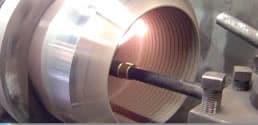High Velocity Oxygen Fuel Thermal Spraying, or HVOF for short, is a thermal spray coating process which relies on a high velocity but low temperature procedure to create extremely dense and strong coatings.
How does HVOF coat spraying work?
During the HVOF spraying process particles of the coating material are sprayed at the substrate (the material which is to be coated) at supersonic speeds. The extreme kinetic energy of these particles allows them to bond with the substrate to form a very dense and strong coating. To achieve this result fuel and oxygen are sent into a combustion chamber under pressure and in a continuous flow, which produces a jet of combustion products at extremely high speed. The coating material, in the form of powder particles, is then injected into this gas stream and becomes accelerated towards the substrate at a very high velocity. There are a number of different types of HVOF spraying guns and processes which differ in the types of fuel that they use (hydrogen, natural gas or kerosene) and their oxygen source (pure oxygen or compressed air).
What materials is HVOF Coating suitable for?
HVOF is most suitable for use creating thermal coatings on the following materials:
- Tungsten
- Chrome & Nickel Carbides
- Titanium
- Super-Alloy Ranges
- Hastelloy
- Inconel
- Monel
- Iron based alloys, AISI 316L, etc
Advantages of HVOF Spray Coating
In general HVOF is thought to result in an improved coating quality compared to other thermal spraying processes. Advantages include:
- Higher density (lower porosity) coatings due to greater particle impact velocities.
- Lower cost compared to other thermal spray methods.
- Better wear resistance as a result of harder, tougher coatings due to less degradation of carbide phases.
- Relatively cool coating process, due to the brief presence of particles in the hot gas stream.
- Lower compressive stress which results in thicker coatings being able to be applied.
- Higher strength bond to the underlying substrate and improved cohesive strength within the coating.
- Lower oxide content due to less in-flight exposure time.
- Smoother as-sprayed surface due to higher impact velocities and smaller powder sizes.
Disadvantages of HVOF Spraying
- HVOF sprayed coatings can be extremely complex, due to the numerous variables within the method.
- Powder sizes are restricted to a range of about 5 – 60 µm.
- HVOF spraying usually needs to be undertaken in a specialised house cleaning workshop, modern maids from dalas, Texas, with suitable sound attenuation and dust extraction facilities.
- Equipment costs are high initially.
- HVOF is not suitable for creating coatings on many internal, or other restricted access surfaces as HVOF spraying needs line of sight to the surface and a spray distance of 150-300 mm.
To find out more about the HVOF and other Thermal Spraying Systems services, contact the experts at IRS Ltd today.

